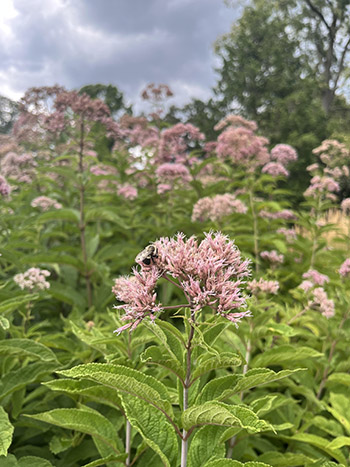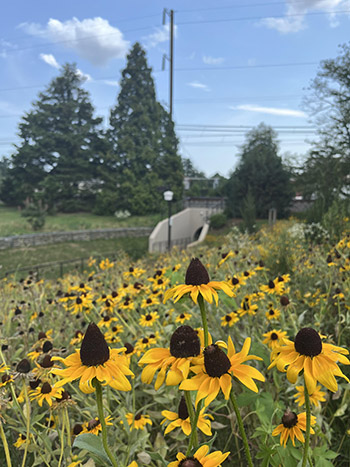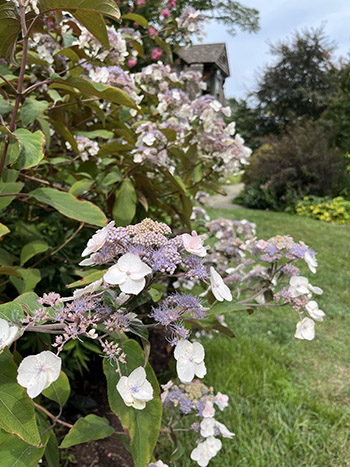
Plants of the Week: July 28
Guest Author: Seamus Lewin, 2024-2025 Public Horticulture Intern

Eutrochium purpureum (sweet Joe-pye weed)
Many of the new plantings around the Dining Center look beautiful around this time of year. In the midst of all this beauty, one cluster of plants stood out to me; the Eutrochium purpureum (sweet Joe-pye weed).
Situated on the south side of the Dining Center and Community Commons, these flowers stand out not only for their height and frosty pinkish flower clusters but also for their appeal to pollinators.
Sweet Joe-pye weed is a large clumping perennial with multiples of sturdy stems and whorls of attractive foliage. These stems are topped with clusters of small tubular pinkish-white flowers that resemble a dome. This species thrives in sunny or partly shaded sites, and in either dry or moist soils, making it fairly adaptable. Joe-pye weed mainly flowers from July to September and is very attractive to a variety of insects. The vanilla scented blooms are frequented by pollinators like bees and more commonly butterflies. photo credit: S. Lewin

Rudbeckia fulgida var. fulgida (black-eyed Susan)
On the northern entrance to the Heat Plant tunnel, you can find a sprawling field full of a wonderful golden flower with a pronounced dark cone. The rolling hills and contrast of color creates a rather picturesque scene made possible by the flowers of Rudbeckia fulgida var. fulgida, commonly known as black-eyed Susan.
Rudbeckia fulgida var. fulgida is a low maintenance and resilient wildflower. It tolerates heat and humidity well and with the exception of soggy soil, it is able to grow in almost any condition. It has a long flowering season, continuing for almost three months from late summer until autumn. A great plant for home gardens with its ease of care, affinity for pollinators and birds, and its use in flower arrangements.
Butterflies and bees pollinate these flowers and seed-eating songbirds enjoy the seeds as a food source thus helping to spread the plant in the process.Additionally, Rudbeckia fulgida var. fulgida is a wonderful cut flower that stays quite fresh in arrangements. photo credit: S. Lewin

Hydrangea aspera ‘Burgundy Bliss’ (Plum Passion® rough-leaved hydrangea)
With so many different species and cultivars of hydrangea at the Scott Arboretum, it can sometimes be difficult to appreciate their individual beauty. However, one that is never difficult to recognise or appreciate is Hydrangea aspera ‘Burgundy Bliss’ or the ‘Plum Passion®’ hydrangea.
Situated on the western edge of the Terry Shane Teaching Garden this hydrangea catches the eye with its wispy purple flowers and burgundy, green, and purple foliage.
Hydrangea aspera ‘Burgundy Bliss’ is a deciduous shrub with lace-cap flowers and is also the first purple-leafed hydrangea. Generally speaking, foliage emerges green flushed with purple, eventually maturing to deep reddish purple with rosy undersides. This hydrangea grows well in most light conditions ranging anywhere from mostly sun to mostly shade and does well in average, rich and well-drained soil making it relatively easy to grow. As a result of its size and color, it is a wonderful border plant for gardens. photo credit: S. Lewin





No Comments